Deciphering a Short Snorter From My Father
Introduction
It was in early January 2015 that my father’s older sister, Orpha Ann Gatch, passed away in Terrace Park, Ohio at the age of 95. One can never be fully certain about such things, but I believe my Aunt Ann had a full and happy life, centered on her long career as a music teacher and an extended family that, in good part, has remained in the Cincinnati area. On that frosty morning of Ann’s interment at Greenlawn cemetery in nearby Milford, one thing that I did not expect to see was an honor guard mustered out by the local American Legion post to provide her a gun salute. Aunt Ann, I then remembered, had served as a WAVE during World War II. Posted to Pensacola, Florida, her job had been to instruct pilots on the Link Trainer, an early flight simulator. I had always liked that fact since its inventor, Edwin Link, built the first simulator out of parts from his father’s organ building business. I imagined that for my aunt, whose own musical strengths lay in the piano and organ, operating a machine like that would have come naturally to her.
The ceremony at Greenlawn also gave me the opportunity to pay respects at my father’s grave. Ann’s younger brother John had died over twenty years earlier. Also a veteran, John Newton Gatch served in Europe as a radio operator in the Ninth Air Force, 410th Bomb Group, 644th Bomb Squadron. Of the mementos my father left behind, very few shed any light on his wartime service. The government itself could provide little detail, as my father’s records were among the many destroyed in the 1973 fire at the National Personnel Records Center. Fortunately, I still possess a minute photostatic copy of his discharge papers. With my Aunt Ann’s passing, another item came into my possession. Pictured below, the framed display consists of a Ninth Air Force patch, a group photograph (which includes my father, standing, second from the right) and a one-pound note turned into a “short snorter” –a banknote memorialized with numerous signatures, presumably those of the people pictured in that group.
In the following account, I take a closer look at that short snorter, and the names written upon it. This is the story of my attempt to decipher a short snorter from my father.
My Father's Short Snorter
As part of currency lore, the phenomenon of the short snorter is interesting, and well understood (see, for example, the documentation collected by the Short Snorter Project at www.shortsnorter.org). An artifact of military life, short snorters were banknotes signed by groups of people who had embarked upon a voyage, or had participated in some event that the group wished to memorialize. The etymology of the expression evidently has something to do with the (mis)measurement of alcoholic drinks. Unless it was signed by somebody famous, the significance of any particular short snorter resides in the experiences and accomplishments that each commemorates. In the case of my father’s short snorter, to my knowledge none of its signatories achieved any fame or notoriety in any conventional sense. Without knowing the circumstances under which it was made, the note’s signatures would be difficult to attribute. In this case, however, not only did I know where my father served, but I have the photograph of a group of men likely to be among the signatories. The challenge then became: could I not only attribute the signatures on the note, but also match them with individuals in the photograph?
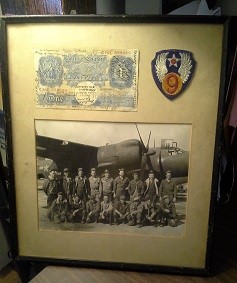
My father's short snorter display
In a world before digitized, searchable records, such an undertaking would have been daunting. Now, however, thanks to the internet (specifically the National Archives database on veterans, as well as genealogical and historic newspaper websites), it has become much easier to access fundamental information about most people, even those who never achieved any particular prominence in public life. In the case of my father’s short snorter, then, the first task was to transcribe the signatures on each side of the note, which involved some enlargement, image-flipping, and a bit of eye strain:
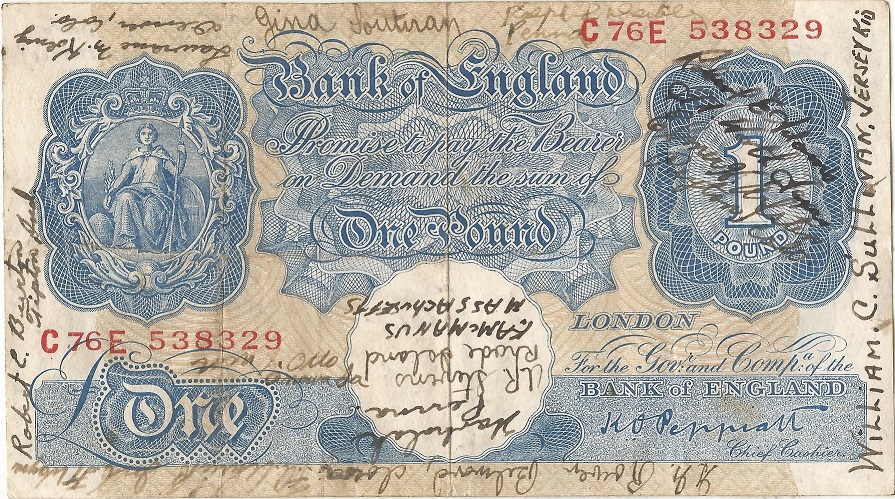
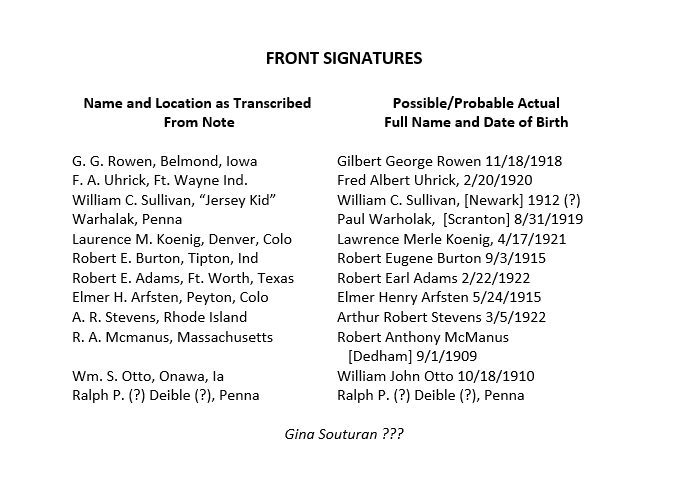
Thanks in particular to the filtering options available at Ancestry.com, it was possible to search using different spellings if a signature was indistinct. The listing of a hometown and state made attribution much easier, but not absolutely necessary. For example, what looked like “Warhalak, Penna” later seemed more likely to be “Warholak”, thanks to personnel records under that name which specifically referenced the Army Air Corp. The lack of any Pennsylvania town did not prevent me from narrowing it down to Scranton. All things being equal, the smaller the hometown, the greater confidence I had in the correctness of a match. Lud Bevill (back) caused me some difficulty, as I first read the signature as “Leed” (or perhaps “Fred”) Bevile; however, the geographical limitation of Toccopola, Mississippii eventually enabled me to recognize my initial mistake.
While specific deployments were not regularly noted in the National Archive records, in some cases state-level data did confirm the signatories’ identities. For example, the Iowans William Otto and Gilbert Rowen (signatures on the front) both applied for soldiers’ bonuses through their home state, and the record of each lists them as having belonged to the 410th Bomb Group, 644th Bomb Squadron. Moreover, the signatures on their bonus applications are good matches to those on the note and on their draft cards (see below).
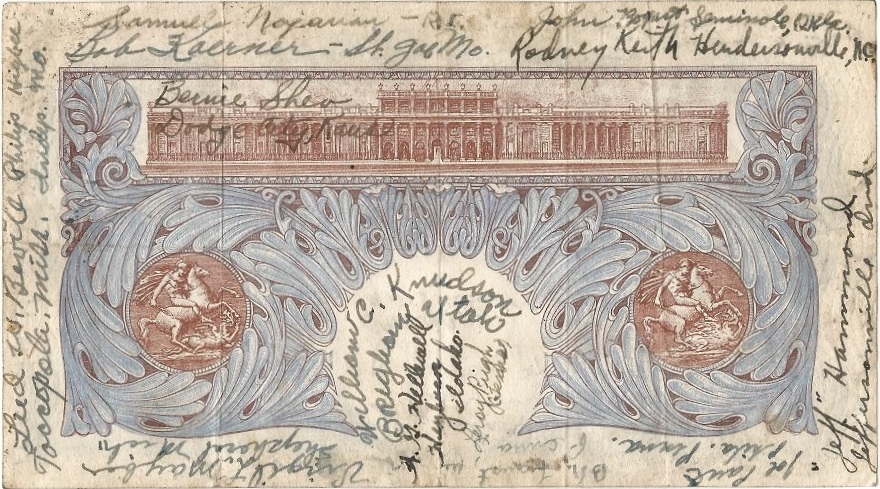
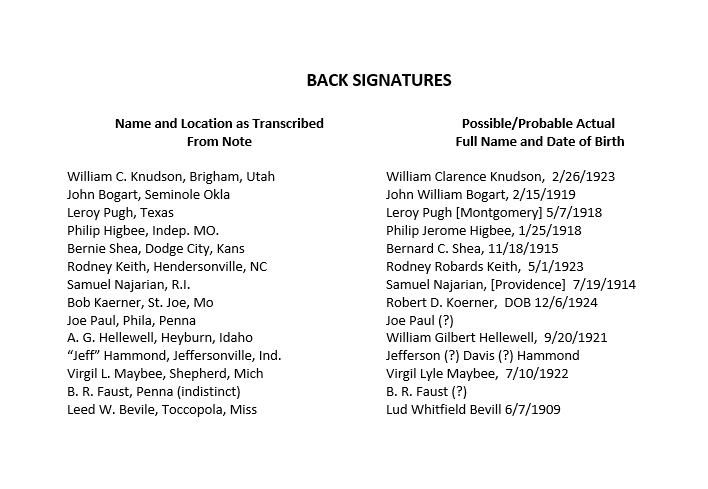
The Signature Evidence
Veterans’ records available online from the National Archives through Ancestry.com can confirm at most that the person named served in the Army Air Corp during World War II, but not where. Draft registration cards, available at the Fold3.com website, helped me confirm signatures in seventeen cases: Adams, Arfsten, Bogart, Burton, Hellewell, Higbee, Keith, Knudson, Koerner, Najarian, Otto, Pugh, Rowen, Shea, Stevens, Uhrick and Warholak. In Fred Uhrick’s case, an additional signature appeared on a marriage certificate (though dated some forty years after the war). Though he signed only his last name, and merely put “Penna” as his place of origin, both Paul Warholak’s draft card and veteran’s compensation form signatures appear reasonably similar; moreover, his 1989 obituary notes that he was an Army Air Force veteran.
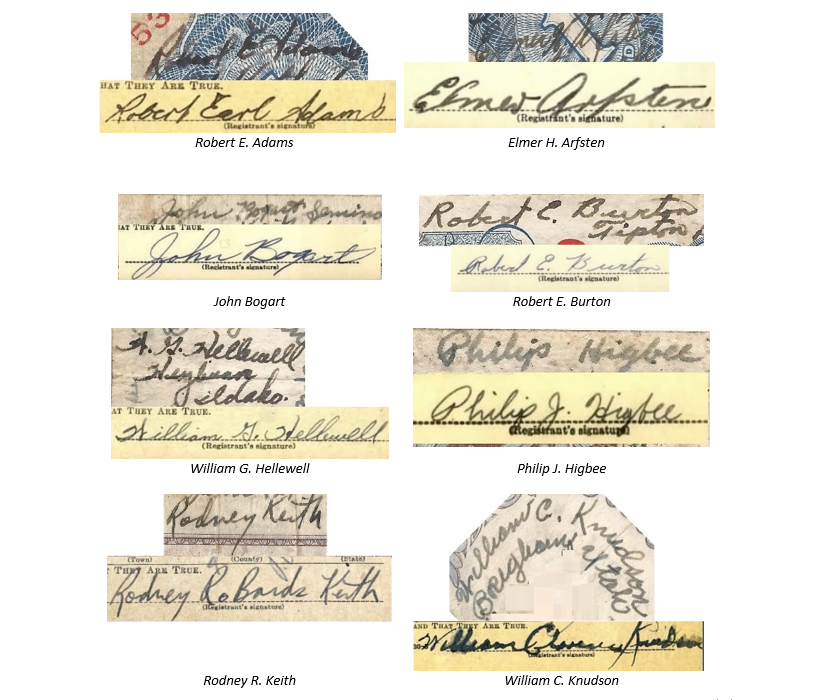
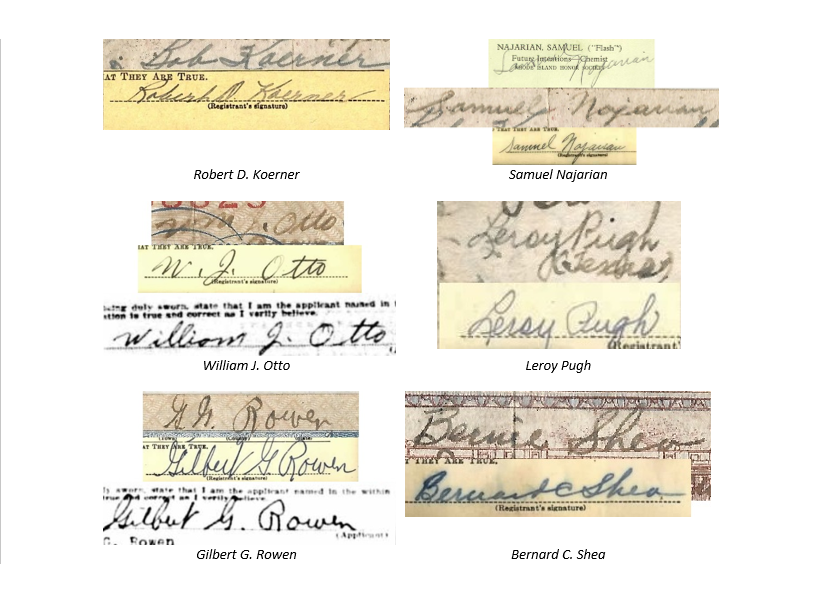
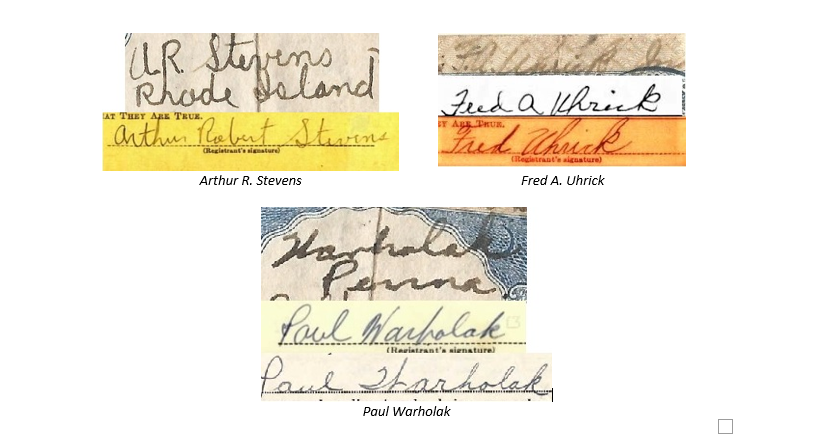
In several cases, draft registration cards either didn’t exist for the person or weren’t entirely useful. Lud Bevill’s draft card features a printed name totally unlike the cursive scrip found on the short snorter. For Leroy Pugh (back of note), the signature on his draft card was an uncertain match to that on the short snorter. However, his affiliation with the 644th Bomb Squadron could be confirmed by a photograph of his gravestone (pictured below). Likewise, in William Knudson’s case the signature match is not unambiguous. His gravestone (also below), includes at the bottom right the inscription “WW II VET SGT 9TH AF.” For Bob Koerner (also back of note), his service in the 410th Bomb Group is noted in his obituary. Higbee’s (back of note) obituary also cites his military service in the same Group. As with Knudson, Elmer Arfsten’s (front of note) gravestone in Texas describes him as “M SGT US AIR FORCE WORLD WAR II KOREA”. Hellewell’s and Burton’s gravestones both refer to their Army Air Force service. While there is no mention of where Rodney Keith served, the signature on his draft card is an excellent match to that on the note. In the case of William C. Sullivan, while I can identify the “Jersey Kid” in the photographs below, I am less confident about his enlistment record, which I was unable to cross-check so as to confirm his exact date of birth. Sullivan is a common name, and New Jersey a populous state.
In only four cases did these search tools leave me no more certain than when I began. Joe Paul, “Jeff” Hammond, B.R. Faust , and Ralph Dieble either lacked records that corresponded to their hometowns, or had multiple matches that I could not narrow down further. Above all, the signature of a female name, “Gina Souturan”, on the front of the note remains a complete mystery.
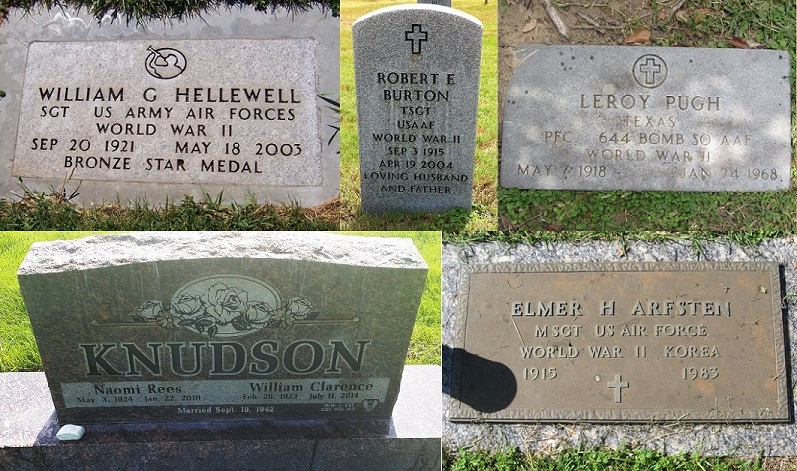
The Photographic Evidence
For a few evenings’ work by a genealogical neophyte with publicly-available online records and a glass of wine (O.K., maybe more than one glass!), these results didn’t represent a bad start! I was particularly gratified at the number of evident matches between the short snorter signatures and what appeared on the draft registration cards. Now, what of my photograph? The first and obvious thing to note is that the number of signatures (twenty-six) doesn’t match the number of men present (seventeen). Enlarging the photograph immediately provided one clue: The fellow kneeling second from the right wears a jacket with “B. Sull-“ visible—there’s the “Jersey Kid”! Another clue comes from the cap visor of the pale fellow crouching in the first row, fourth from the left. Thereon are clearly the letters “LUD”, thus identifying him as Lud Beville.

THE FIRST GROUP PHOTOGRAPH
Putting names to faces: In addition to John Gatch (standing second from right), Samuel Najarian is most likely just to his left. William Sullivan—“B. Sull” visible on his jacket—is kneeling directly in front of Gatch. Next to Sullivan, on the farthest right, may be William Knudson. Rodney Keith may be standing second from the left. Also second from left, kneeling is William Hellewell. Fourth from left, kneeling, is Lud Beville

Lud Beville and Bill "the Jersey Kid" Sullivan, in the photograph above, identified by their clothing.
Otherwise, photographic confirmation of who’s who only depends upon the existence of other images to provide matches. Moreover, unlike matching signatures, matching faces is not at all as straightforward, given the differences in context, light and shading from one photograph to another. Thus, I am much less confident in pronouncing upon the identity of any given pair of images. Also, as a matter of bureaucratic record, unlike signatures, photographs of servicemen were typically not collected. Nonetheless, two possible photographic resources available through Ancestry.com are scanned copies of high school yearbooks (typically from the mid- to late-1930s) and any pictures that have been fortuitously uploaded to public family trees by other genealogical researchers. For my purposes, this latter resource produced a number of happy results. The first, and most tantalizing, photographic find proved to be a second, and larger, group picture that includes by my count at least fourteen of the sixteen individuals pictured in my first group picture (alas, my father was not part of the second picture) plus eleven others. Also available are portraits of Philip Higbee (who, it turns out, was one of four brothers serving in the war), and of Bill Hellewell, posing proudly in his 9th Air Force uniform. In addition, photographs, of Robert Adams and William Knudson also turned up. While I believe both photographs depict the individuals who signed the notes, I am less certain as to where (or even if) they appear in the group photographs.
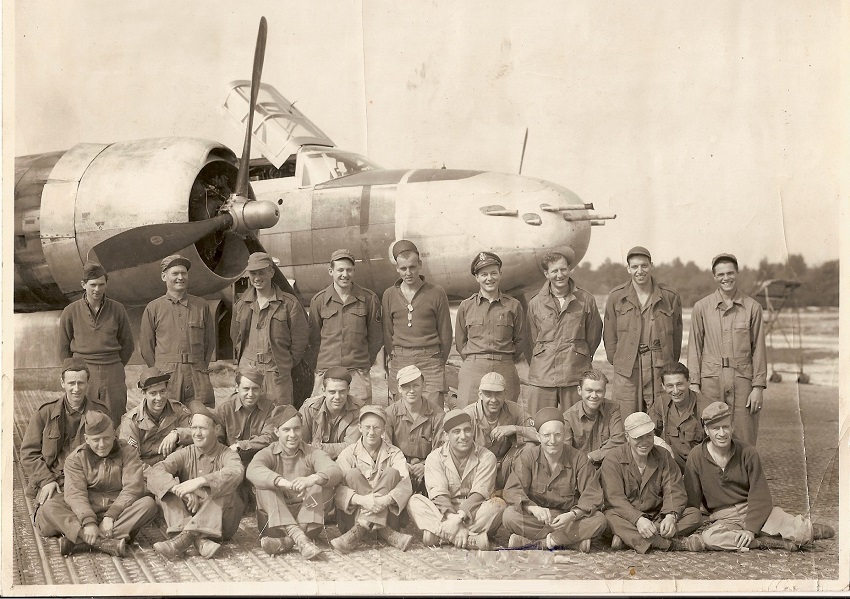
THE SECOND GROUP PHOTOGRAPH
Higbee appears here kneeling, second row, last place on the left. Najarian appears just to Higbee’s right. Sullivan is sitting, first row, farthest right. Just to the left of him may be Knudson. Hellewell is also sitting, third from right. Lud Beville is sitting two places to the right of Hellewell, and indeed in the exact same spot as in the first group photograph. Keith may be standing third from the left. All four appear in the first photograph. Koerner is standing in the third row, second from right. Lawrence Koenig (with dogtags) is standing exactly in the middle.
It would be tempting to declare the second photograph to be the more complete depiction of who signed my father’s short snorter. In addition to identifying Hellewell from his separate portrait, high school yearbook pictures suggest the visual identification of Robert Koerner, Lawrence Koenig and Samuel Najarian. Indeed, by chance the particular scanned copy of the yearbook in which Najarian’s picture appears was actually autographed by Najarian! The match between his high school signature and the short snorter (especially in the rendering of his last name) is, I think, indisputable.
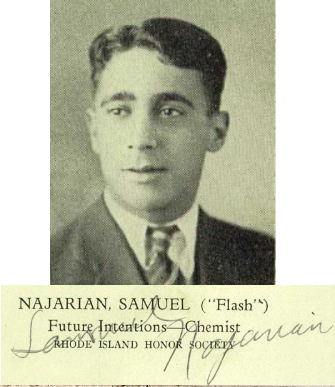
Samuel Najarian, in his autographed high school yearbook
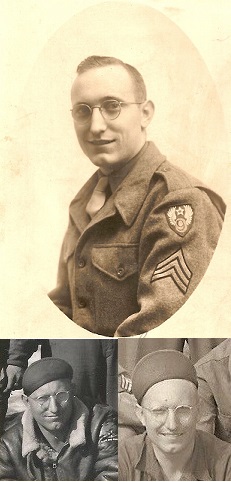
Bill Hellewell
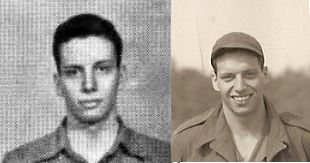
Robert Koerner: high school 1942 and army

Samuel Najarian: high school 1932, army,and from his obituary 2006
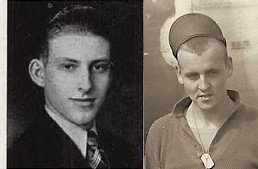
Koenig: high school 1937 and army
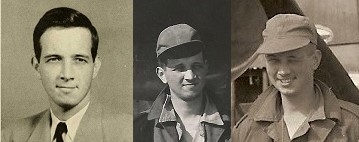
Rodney Keith: college 1947 and army
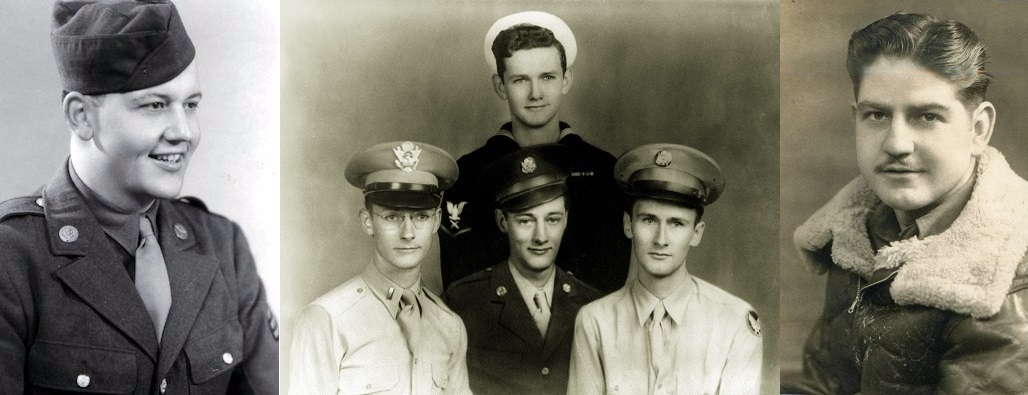 William Knudson, left photograph; the four Higbee brothers, center photograph, including Robert, bottom right; and Robert Adams, right photograph.
William Knudson, left photograph; the four Higbee brothers, center photograph, including Robert, bottom right; and Robert Adams, right photograph.
Robert Adams doesn't obviously resemble anybody in the two group photographs above.
Investigations like this tend to peter out when the leads are no longer so obvious. In the course of deciphering this short snorter, I learned basic things about some of these men’s lives after their military service. For example, Lawrence Koenig became an inspector for the U.S. Department of Agriculture, working at the U.S.-Mexican border. Leroy Pugh was a waiter in Conroe, Texas, where he died of a heart attack at age 49. Phil Higbee was employed at a Standard Oil refinery until 1980. “Clair” Knudson returned to Brigham City, Utah, where he married Naomi and ran a roofing supply company. Bill Hellewell served the LDS Church in various capacities. Adams stayed on in the Air Force until 1966. Paul Warholak was a commander of the American Ukrainian Veterans Association, had nine sisters (!) and otherwise remained active in the Ukrainian Orthodox Church. And John Gatch joined the Foreign Service, serving as a political officer in posts ranging from Poland and Hong Kong to countries in the Middle East.
The most certain conclusion I have drawn from this preliminary exercise is that genealogical research can be a mighty deep rabbit hole, and that anyone wishing to do some serious spelunking needs to bring a long rope. Further work to attribute the signatures on my father’s short snorter would most likely require contacing the living next-of-kin. Anyone who understands genealogical research (especially military records) better than I is welcome to advise me what to do! In any event, I am still heartened that even this initial undertaking infused a long-mute banknote with some of its old voices.
Finally, there is one obvious question about whose answer I can only speculate: Why is my father’s signature not on the note? The most plausible conjecture is that, at the time that this short snorter was made, each person signed, in round-robin fashion, everyone else’s note except his own. This leaves me with the tantalizing possibility that there could then exist up to twenty-five additional notes, somewhere in the world, all bearing upon them the signature of John N. Gatch. I’ll have to keep my eyes open!
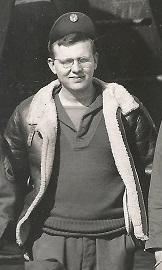
John N. Gatch, Jr. 1921-1992


